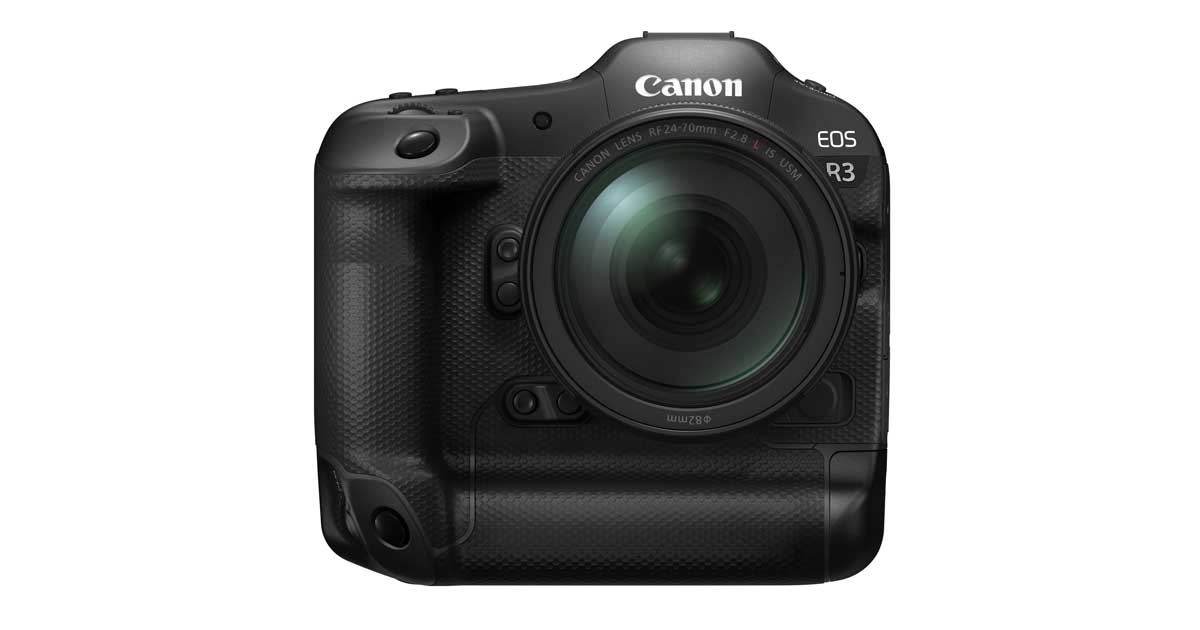
Canon EOS R3 finally revealed
Posted on Sep 14, 2021
After several months of development notices, the Canon EOS R3 has been officially announced – and it looks awesome
The Canon EOS R3 is a camera aimed at news and sports professionals. It’s the result of extensive research among current EOS-1 users. Thus, the EOS R3 is an amalgamation of the best of the R and EOS-1 series. The new camera’s handling, control layout, and even the battery, comes from the EOS-1. Canon was keen to stress that for existing EOS-1 users, an EOS R3 would be a similar, instinctive experience – so no need to learn their way around the control layout. Even the 5.76m dot EVF is blackout-free, with a 120fps refresh rate. It’s the first Canon mirrorless with an optical viewfinder simulation mode, to help photographers easily make the transition from DSLR.
The body has dust and weatherproofing like the EOS-1 series, but durability is not to that standard – tough, but not super-tough. The implication of this means there’s room for a top-end EOS R, with the physical robustness of an EOS-1. The EOS R3 is home to an in-body image stabilisation system, with up to 8EV of benefit. It is powered by the LP-E19 battery, with USB-C charging possible.
The EOS R3’s sensor is a brand-new Canon 24.1-megapixel unit. It’s a back-side illuminated, stacked CMOS sensor – to give the best balance of resolution, speed, ISO capability and file size. Native ISO extends up to 25,600 with expansion to 102,400. The stacked design has lots of circuitry behind the light-gathering pixels, so getting the information off the sensor is super-quick. Speed is a key aspect of the EOS R3 and it uses the Canon DIGIC X processor.
Top shutter speed with the electronic mechanism is 1/64,000sec – the world’s fastest – and flash can be synced at 1/180sec, too. Mechanical shutter flash sync is 1/200sec and 1/250sec with the electronic first curtain.
Rolling shutter effect has been minimised, and it’s a lot less than the EOS R5.
For capturing action, the EOS R3 can shoot 14-bit Raws at 15fps or 30fps with the electronic shutter and AE/AF tracking. Using the mechanical shutter, top shooting rate is 12fps with AE/AF tracking. Files are written to dual memory card slots: CFexpress B and SD. Shutter lag is 20ms. This is adjustable, again to help those transitioning from DSLRs, so the EOS R3 can match their existing kit.
Autofocusing is handled by the Dual Pixel CMOS AF II sensor and has human and animal eye detect, like the EOS R5. There is also vehicle tracking, using an algorithm designed to deal with racing cars and motorbikes. The system will detect a rider’s crash helmet and can be set to prioritise the vehicle or the helmet.
Speed, as you would expect, is impressive. The EOS R3 has the fastest AF in an R series camera, measuring 0.03ms. With all the focusing algorithms in the EOS R3 improved, its AF is even effective compared with the EOS R5.
Eye control AF was a feature highlighted early on in the EOS R3’s development. Inevitably, comparisons were made with Canon’s eye-controlled focusing, seen on the EOS film SLRs – but the new concept is different. Whereas the old tech was used for selecting the AF point you want to use, the EOS R3’s is for initial acquisition of the subject, then it lets the camera track them. This mode is about picking up and deciding what to focus on, not using the eye to track. Canon showed the system working with two motorbikes running side by side. To use eye control tracking AF, you look at the rider you want to focus on, partially depress the shutter button, and the camera will acquire the bike you are looking at. The camera will now take over and focus track on that subject while the release is held. If you want to change tracking to the other bike, momentarily take your finger off the shutter button to cease focusing, look at the desired subject and partially depress the shutter button again – the camera will now focus track that. The system works across the whole image frame.
For the best results, the eye control tracking AF needs to be calibrated to your eye. This is done with eight low-powered, infrared LEDs looking back into your eye – a technology from Canon’s medical division. It is recommended to do this four times in the shoot environment – not in the living room before you head to the race track. It looks like an amazing feature, but how it will work with a group of people, a flock of birds or a field of racehorses, only time will tell.
Video has 6K/60p, Raw capability, and 4K oversampled from 6K. As you’d expect, there’s a wide choice of formats, including DCI and 4K UHD. Rolling shutter has been reduced on video, too, and 4K/120p image quality has been improved. Video recording times are better, with six hours of regular video and 90 minutes at the high frame rates. The limiting factors are card size and battery power. Video shooting is also possible with the EOS R3’s full range of focusing modes.
The EOS R3 has a modified hotshoe – it’ll accept standard accessories, but there is now a 21-pin power connection. This allows you to use camera-powered options. The DM-E1D mic and ST-E10 Speedlite transmitter are compatible.
Sales start in November with a body-only cost of £5879.99.
Canon has also grown the RF lens system, announcing the RF 16mm f/2.8 STM and the RF 100-400mm f/5.6-8 IS USM. Both are compact and lightweight high performers.
The RF 100-400mm f/5.6-8 IS USM has a 5.5EV benefit image stabiliser, which increases to 6EV with an EOS R IBIS-equipped body. Autofocusing is handled by a Nano USM. Minimum focus is just 88cm, so while not macro, it allows you to get in close. This long telezoom weighs in at 635g. Sales start 14 October, with a price of £699.99.
The RF 16mm f/2.8 STM is a compact, but solidly built ultra wide-angle, and uses an STM to keep size down. It is not image stabilised and weighs 185g. Sales of this lens also start on 14 October – the price is £319.99.
Don’t forget to sign up to receive our newsletter below, and get notified about the new issue, exclusive offers and competitions.
Have you heard The Photography News Podcast? Tune in for news, techniques, advice and much more! Click here to listen for free.




